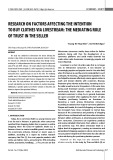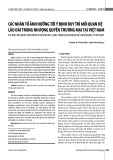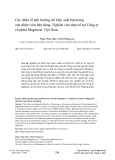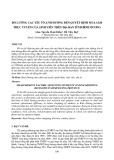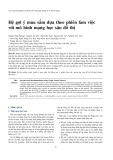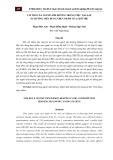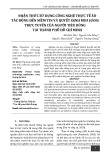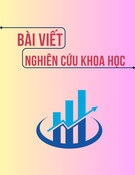275
JOURNAL OF SCIENCE AND TECHNOLOGY DONG NAI TECHNOLOGY UNIVERSITY
Special Issue
THE IMPACT OF GREEN RELATIONSHIP MANAGEMENT ON CORPORATE GREEN PERFORMANCE: THE MEDIATING ROLE OF GREEN OPERATIONS MANAGEMENT IN MANUFACTURING ENTERPRISES IN VIETNAM
Nguyen Thi Kim Tin*
Dong Nai Technology University *Corresponding author: Nguyen Thi Kim Tin, nguyenthikimtin@dntu.edu.vn GENERAL INFORMATION ABSTRACT
Received date: 10/03/2024
Revised date: 24/05/2024
Accepted date: 17/07/2024
KEYWORD
Green operations management;
Green performance;
Green relationship management;
Manufacturing enterprises.
This study aims to explore the relationship between green relationship management, green operations management, and green performance in manufacturing enterprises in Vietnam. This study surveyed 400 executives and senior managers of manufacturing enterprises in Vietnam using a regional quota sampling method to collect data on variables such as green relationship management, operations management green, and green performance. The structural equation model was analyzed using SmartPLS software. Research results show that green relationship management has a positive impact on corporate green performance, and green operations management plays a mediating role in this relationship. This shows that focusing on building green relationships with stakeholders along with good management of green operations in the enterprise will help improve green performance. The study contributes to the theory and practice of green management, providing empirical evidence on the impact of green relationship management and the mediating role of green operations management on corporate green performance.
1. INTRODUCTION
concerns,
environmental
in the relationship between green relationship management and the green performance of enterprises in manufacturing enterprises in Vietnam.
In the context of climate change and increasing the adoption of green management practices has become very important for manufacturing enterprises. Green relationship management and green operations management are considered key factors affecting the green performance of enterprises. This study aims to explore the mediating role of green operations management
Green relationship management involves building and maintaining relationships with customers, stakeholders suppliers, (e.g., governments, etc.) to create value and efficiency in the use of resources while minimizing adverse environmental impacts
276
JOURNAL OF SCIENCE AND TECHNOLOGY DONG NAI TECHNOLOGY UNIVERSITY
Special Issue
development
sustainable
of
manufacturing enterprises better understand how to develop and implement effective green management strategies, thereby contributing to the the manufacturing industry in Vietnam.
2. THEORETICAL BACKGROUND AND RESEARCH METHOD
2.1. Theoretical background
2.1.1. Green relationship management
Green
relationship management
improving
role
in
assess green
to
(GR) focuses on building and managing relationships with stakeholders to support and promote green activities in businesses (Rao & Holt, 2005). This includes enhancing collaboration and stakeholders, sharing with information facilitating in decision- their participation making, and solving environmental problems (Sarkis et al., 2010). At the same time, businesses need to ensure transparency and accountability in green activities, creating trust for stakeholders (Seuring & Müller, 2008; Vachon & Klassen, 2008). The author identifies questions relationship management (external connections) based on the research of Laari et al., (2016), as follows:
(Eiadat et al., 2008; Zhu et al., 2008). Green operations management involves the design, implementation, and control of green-oriented production processes (Diabat & Govindan, 2011; Mollenkopf et al., 2010). The green performance of a business refers to the extent to which a business achieves environmental goals such as emission reduction, energy, and resource consumption, as well as compliance with environmental standards and regulations (Zhu et al., 2012). Previous studies have shown that green relations management (GR) and green operations management (GO) play an important the green performance (GP) of manufacturing enterprises (Eltayeb et al., 2011). In addition, Ng et al., 2013) also affirmed that green relationship management (GR) helps create green value for the organization, thereby improving the green performance of the enterprise. However, most of in this research has been conducted developed economies, and few studies have in focused on manufacturing enterprises Vietnam. As we know Vietnam is one of the fastest-growing economies with increasing industrial production, so research on green management in this field is essential.
2.1.2. Green operations management
management,
the
on
Green operations management (GO) is an important concept in implementing a business's sustainable development strategy. GO refers to the design, operation, and improvement of business processes to minimize negative impacts on the environment (Zhu & Sarkis, 2004). According to Srivastava (2007), GO includes activities such as green product design, green procurement, green supply chain management, green manufacturing, green logistics, and waste management. These activities aim to optimize the use of natural resources, energy, and other resources during thereby minimizing business operations,
The author surveyed 400 executives and senior managers of manufacturing enterprises in Vietnam using a regional quota sampling method to collect data on variables such as green relationship management, green operations green and performance. The results of the study show that green relationship management has a positive effect on the green performance of enterprises, and green activity management plays a mediating role in this relationship. This study provides empirical evidence on the key role of green relationship management and green operations management green performance of enterprises in Vietnam. The results of the study can help policymakers and
277
JOURNAL OF SCIENCE AND TECHNOLOGY DONG NAI TECHNOLOGY UNIVERSITY
Special Issue
attention
pay
not
problems
incentive
of
leading
& Meckling, 1976). In the Green operations management context, this theory explains how to managers may environmental issues without appropriate control and motivation from owners (Surroca et al., 2010).
negative impacts on the environment (Kuo et al., 2019). One of the basic theories related to GO is agency theory. This theory posits that when there is a division between owners and and operators, to information asymmetry arise, inappropriate behavior by the operator (Jensen
Table 1. Scale questions "Green Relationship Management"
Question
Variable name
GR 1
GR 2
GR 3
GR 4
GR 5
GR 6
GR 7
GR 8
Our company collaborates with suppliers to take environmental issues into account in product design Our company develops inbound logistics with suppliers to be more environmentally friendly Our company and our suppliers have a clear understanding of their responsibilities regarding environmental issues Our company prioritizes suppliers with environmental management systems Our company works together with customers to take environmental issues into account in product design Our company and our customers have a clear and mutual understanding of responsibilities regarding environmental issues. Customers have asked us for information about our environmental compliance Our customers have asked our company to ensure the sustainable practices of our suppliers Our customers asked us to implement an environmental management system
GR 9
[Source: The research of Laari et al., 2016)]
connection) based on research by (Ninlawan et al., 2010) and Hsu et al., as follows:
2.1.3. Green performance
related
capabilities,
In addition, resource-based view theory is also an important foundation of GO. According to this theory, the distinct resources and capabilities of an enterprise will affect its sustainable competitiveness (Barney, 1991). In the GO context, capabilities to environmental management such as waste treatment energy-saving capabilities, etc. Can become a source of competitive advantage for businesses (Paulraj, 2011).
The authors identify questions to evaluate (internal
operations management
Green
According to (Zsidisin and Siferd, 2001): “Green performance is defined as the positive results of green initiatives for the natural environment inside and outside the company”. This includes the environmental impacts and improvements resulting from a company's internal sustainability activities as well as the impacts of its external green supply chain activities. This comprehensive assessment of green performance allows organizations to assess the overall environmental impact of their
278
JOURNAL OF SCIENCE AND TECHNOLOGY DONG NAI TECHNOLOGY UNIVERSITY
Special Issue
efforts
chain management
guiding supply chain sustainability strategies and assessing progress toward environmental goals.
The author identifies the questions for green performance assessment based on the research of (Cousins et al.,2019) and (Zhu et al.,2008) as follows:
supply by considering the environmental outcomes of their operations. The company's internal and cooperative suppliers, relationships with distributors, etc., and other partners, can gain a more comprehensive understanding of the company's green achievements. This integrated view of green performance is important for
Table 2. Questions about the "Green Operations Management " scale
Question Variable name
Our company's packaging is reusable GO 1
Our company's packaging uses as little material as possible GO 2
Our company evaluates environmental impact for product development/improvement GO 3
Our company develops products with recyclable raw materials GO 4
Our company develops products with the lowest resource consumption GO 5
Our company develops products with long service life. GO 6
GO 7 Our company purchases based on environmental specifications established by product design
Our purchasing process is carried out with ISO 14001-certified partners GO 8
Our purchasing process follows procedures that minimize environmental impact GO 9
GO 10 Our purchasing process follows product labeling standards to minimize environmental impact
[Source: Ninlawan et al., 2010 and Hsu et al.,]
Table 3. Questions about the “Green Performance” scale
Question Variable name
Our company has increased material recycling over the past three years GP 1
Our company has reduced emissions over the past three years GP 2
Our company has reduced resource use/waste over the past three years GP 3
GP 4 Our company has reduced the use of toxic/environmentally harmful materials over the past three years
[Source: the research of Cousins et al.,2019 and Zhu et al.,2008]
2.2. Hypotheses development
279
JOURNAL OF SCIENCE AND TECHNOLOGY DONG NAI TECHNOLOGY UNIVERSITY
Special Issue
impact of green relationship
H1: green relationship management has a
2.2.1. The management on green performance
positive impact on green performance.
2.2.2. The mediating role of green operations management (GO) between green relationship management (GR) and green performance (GP)
Although green relationship management plays an important role in green performance, it also depends on green operations management. Green relationships between organizations have a significant impact on their green practices and environmental sustainability efforts.
reduced
and
requirements
then help
improve
important role performance
the
According to some recent studies, it can be seen that green relationship management (GR) refers to building, maintaining, and promoting green relationships with stakeholders, including suppliers and customers, customers, and communities (Alkhidir & Zailani, 2020). Research by Alkhidir and Zailani (2020) shows that GR has a positive and significant impact on green performance. In particular, GR helps information create cooperation and green sharing between parties, promoting the sharing of green resources and technology, thereby improving green capacity and minimizing the environmental impact of activities business. Similarly, Zaid et al., (2021) study concluded that GR has a positive influence on green performance through promoting information sharing, collaboration, and green activities with stakeholders. This contributes to improved environmental management, efficient use of resources, organizational emissions (Zaid et al., 2021). In addition, research by Ojo et al., (2019) shows that GR indirect impact on green also has an green performance promoting through innovation and green capabilities of the relationships with organization. Green stakeholders help facilitate the sharing of green knowledge, technology, and resources, thereby enhancing an organization's green innovation and capabilities (Ojo et al.,2019). In summary, studies have shown that green relationship management plays an in of green enhancing organizations through promoting cooperation and sharing information and green resources between related parties.
Based on the above findings, the authors
propose the following hypothesis:
According to research by Zaid et al., (2021), GR has a positive impact on green operations management (GO), including activities such as green management, green procurement, green production, and green distribution. Green relationships with stakeholders help facilitate and promote the implementation of these green operations management. GO then contributes to improving green performance through efficient use of resources, minimizing environmental impact, and enhancing the ability to meet customers' green (Zaid et al.,2021). Similarly, Ahmad et al.,2020) study also showed that GO plays a mediating role in the relationship between GR and green performance. Specifically, GR promotes green activities such as green supply management, green production, and green distribution. These green activities the organization's green performance by reducing emissions and saving energy and resources (Ahmad et al., 2020). The study of Zaid and Bon (2018) also showed the mediating role of GO in the relationship between GR and green performance. GR has a positive impact on GO, including activities such as green procurement, green production, and green logistics. These
280
JOURNAL OF SCIENCE AND TECHNOLOGY DONG NAI TECHNOLOGY UNIVERSITY
Special Issue
manufacturing enterprises in Vietnam is shown in Figure 1 below.
Figure 1. Proposed research model
3. FINDINGS AND DISCUSSION
3.1. Measuring variables
green activities then have a positive impact on the organization's green performance (Zaid & Bon, 2018). In summary, studies have shown that green operations management (GO) plays an important mediating role in the relationship between green relationship management (GR) and green performance. Green relationship management promotes green operations management, so contributing to improving an organization's green performance. Therefore, referring to the existing literature, the author hypothesized that::
H2a: Green relationship management has a operations
impact
green
on
positive management.
H2b: Green operations management has a impact on green
The variables in this study were developed based on previous research and measured on a 5-point Likert scale ranging from 1 (strongly disagree) to 5 (strongly agree). The analysis results excluded 9 variables (GO1, GR4; GR1; GR6; GR9; GO7; GO8; GR8; GO5) due to loading factor below 0.7.
positive and significant performance
Table 4. The analysis results excluded 9 variables
H2c: Green Relationship management
significantly impacts green performance
GO1 Our company's packaging is reusable
2.3. Research method
GO5 Our company develops products with the lowest resource consumption
GO7 Our company purchases based on environmental specifications established by product design
GO8 Our purchasing process is carried out with ISO 14001-certified partners
GR1 Our company collaborates with suppliers to take environmental issues into account in product design
GR4 Our company prioritizes suppliers with environmental management systems
GR6 Our company and our customers have a clear and mutual understanding of responsibilities regarding environmental issues.
GR8 Our customers have asked our company to ensure the sustainable practices of our suppliers
The author conducted an interdisciplinary in survey of manufacturing enterprises Vietnam. Target users are managers from departments related to supply or purchasing. The study used a quota sampling method, with equal proportions of participants from the North, Central, and South regions. The survey was conducted from early March 2024 to late May 2024 using an online questionnaire designed using Google Forms. Data were collected through a survey of executives and senior managers of manufacturing enterprises in Vietnam. The author received a total of 400 responses, of which 368 were ultimately usable (response rate approximately 56.5%). The structural model was analyzed through many stages using SmartPLS software. The model synthesizing the impact of green relationship management on the green performance of
GR9 Our customers asked us to implement an environmental management system
281
JOURNAL OF SCIENCE AND TECHNOLOGY DONG NAI TECHNOLOGY UNIVERSITY
Special Issue
This decision was made to ensure the reliability and validity of the constructs. The suitability and fit of the remaining variables and the overall structural model are presented in detailed statistical analyses, including Table 5 and Figure 2, which provide evidence of the research methodology's rigor and quality.
Figure 2. Model parameters
Table 5. Confirmatory factor analysis
Structure Rho_A VIF Cronbach' s Alpha Composite Reliability Outer Loadings Average Variance Extracted (AVE)
0.839 0.841 0.882 0.555
0.727 1,660 Green operations GO 2
0.807 2.116 GO 3
0.746 1,737 GO 4
0.704 1,506
0.727 1,616 GO 6 GO 9
0.755 1,690 GO 10
Green relationships 0.823 0.826 0.883 0.654
0.767 1,699
0.839 2.197 GR 2 GR 3
0.857 2.136 GR 5
0.766 1,528 GR 7
0.836 0.839 0.890 0.670
0.805 1,737 Green performance GP 1
0.794 1,729 GP 2
0.850 2,040 GP 3
0.824 1,808 GP 4
3.2. Analysis of reliability and validity
extracted
The study used Confirmatory Factor Analysis (CFA) to test the validity and reliability of the constructs. Table 5 also presents the results of the Confirmatory Factor Analysis, showing the factor loadings, average variance (AVE), Composite Reliability (CR), and Cronbach's Alpha (CA).
The appropriate fit indices of the model are χ² = 848.911, NFI = 0.904 (>0.9) and SRMR = 0.073 (<0.08), showing that the model fit level is acceptable on All constructs are greater than 0.7 and are significant at the p < level 0.05, indicating convergence of the constructs (Fornell and Larcker, 1981). Composite reliability and Cronbach's Alpha confirm the reliability of the measures used in the study,
282
JOURNAL OF SCIENCE AND TECHNOLOGY DONG NAI TECHNOLOGY UNIVERSITY
Special Issue
3.4. Evaluate the structural model
with all values exceeding the acceptable threshold of 0.7.
3.3. Common method variance
In structural modeling, both the causal relationship and the measurement model are evaluated simultaneously. The results show that all indicators meet the requirements: SRMR=0.073 < 0.08; GoF = 0.616 > 0.36, considered significant (Vinzi et al., 2010). All hypotheses were supported by the data at a significance level of p < 0.05 (Table 7). These findings confirm that the structural model is suitable with high predictive ability.
Table 7. Hypothesis testing results
Relationship GRGO GOGP GRGP
The phenomenon of common variance occurs when a common factor related to the measurement method influences different assessments. In the study, the authors used Harman's single-factor analysis, a Post Hoc procedure, to test whether an individual factor contributed to differences in outcomes. data (Chang et al., 2010). The result of testing the variance of the first component is 43,855 < 50% (Table 6), showing that there is no common variance of the method.
0.686 0.518 0.417 Original Sample (O) Table 6. Results of common method variance analysis 0.685 0.522 0.414 Sample Mean (M) Initial Eigenvalues 26.572 15.549 11.286 t Statistics Component Total P Values 0.000 0.000 0.000 Cumulative % Variance %
6.140 43,855 43,855 1
Based on the experimental results, we can
1.165 8,318 2 52,173
conclude that the effects of the variables are proportional:
3 .860 6.146 58,319
Effect of green relationships on green
4 .796 5,687 64,006
activities: β=0.686 (p=0.000).
Effect of green activities on green
5 .737 5,263 69,269
performance: β=0.518 (p=0.000).
6 .641 4,577 73,847
Effect of green relationships on green
7 .559 3,994 77,841
performance: β=0.417 (p=0.000).
8 .550 3,926 81,767
Therefore, the hypotheses H1, H2a, and
9 .529 3,775 85,542
H2b have been proven to be completely consistent.
10 .518 3,702 89,245
3.5. Analyze the role of mediating variables
11 .431 3,080 92,325
To
test hypothesis H2c,
12 .402 2,871 95,195
13 .366 2,616 97,811
Extraction Method: Principal Component Analysis
14 .306 2.189 100,000
the author analyzed the mediating role. The results for Green Relationship Management significantly impact green performance (β = 0.686; t = 26.572; p < 0.001) (Table 8). Therefore, green performance management plays a positive mediating role in the relationship between
283
JOURNAL OF SCIENCE AND TECHNOLOGY DONG NAI TECHNOLOGY UNIVERSITY
Special Issue
green relationship management and green performance.
operations management
in
Table 8. Results of analyzing the role of mediating variables
Relationship GRGO GOGP GRGP
management on green operations management. This study contributes to expanding previous studies by examining the intermediary role of green the relationship between green relationship management and the green performance of manufacturing enterprises in Vietnam.
0.686 0.518 0.773 Original Sample (O)
0.685 0.522 0.772 Sample Mean (M)
26,572 15,549 39,720 t Statistics
P Values 0.000 0.000 0.000
4. DISCUSSION AND CONCLUSION
4.1. Discussion and conclusion
that
is an
The research results show that green relationship management has a positive and significant impact on green operations management, which shows that establishing and maintaining green relationships with stakeholders such as suppliers, customers, and government will promote green operations management in businesses. In addition, green operations management was also found to have a mediating role in the relationship between green relationship management and green green demonstrating performance, operations management important mechanism through which green relationship management influences green performance.
its
research
In this study, I studied the impact of green relationship management on corporate green performance: The mediating role of green operations management in manufacturing enterprises in Vietnam shows all the indicators. The numbers meet the necessary criteria, confirming suitability with highly intelligent prediction capabilities.
results have practical for business managers and
The implications policymakers as follows:
First,
the research results show
(GP)
in
their partners
intermediary role
in
that building and maintaining green relationships with stakeholders such as suppliers, customers, and government will help promote green businesses. operations management to focus on Therefore, businesses need building sustainable green relationships with strategic partners. Businesses need to focus on activities such as information sharing, joint planning, and collaboration on green initiatives with to strengthen green relationship management.
This study provides valuable empirical evidence on the important role of green relationship management (GR) and green operations management (GO) in enhancing at corporate green performance manufacturing enterprises in Vietnam. The results of that green the study show relationship management has a positive impact on green operations management, and green operations management has a positive effect on the green performance of enterprises. Moreover, green operations management plays an the relationship between green relationship management and the green performance of manufacturing enterprises in Vietnam.
procurement,
green
This result is consistent with previous studies on the impact of green relationship
Second, the research results also show that green operations management such as green production, green logistics, etc., play an important intermediary green role
enterprises'
promoting
in
284
JOURNAL OF SCIENCE AND TECHNOLOGY DONG NAI TECHNOLOGY UNIVERSITY
Special Issue
REFERENCES
Production
Alkhidir, T., & Zailani, S. (2020). The impact of green relationship management on green innovation and green performance. and Sustainable Consumption, 23, 1-12.
performance. Therefore, businesses need to prioritize investing and implementing green operations management to improve green performance. In sum, the combination of green relationship management and green operations help manufacturing management will enterprises in Vietnam achieve better green.
implementing
green promoting
thereby
Ahmad, WNKW, de Brito, MP, & Tavasszy, LA (2020). The influence of external factors on supply chain sustainability goals of the oil and gas industry. Resources, Conservation and Recycling, 154, 104608.
From a policy perspective, this study suggests that the government needs to have policies and measures to support businesses in establishing, green relationships management operations and management, green performance and green economic development in Vietnam.
4.2. Limitations and future research
Barney, J. (1991). Firm Resources and Sustained Competitive Advantage. Journal of Management, 17(1), 99-120.
Journal
Jensen, M.C., & Meckling, W.H. (1976). Theory of the Firm: Managerial Behavior, Agency Costs and Ownership Financial of Structure. Economics, 3(4), 305-360.
for
Kuo, TC, Tseng, ML, Lin, CH, & Wang, RW (2019). Identifying Sustainable Behavior Factors Implementing Green Operation Practices. Journal of Cleaner Production, 209, 1151-1161.
factors
such
Ng, K. K. H., Ding, X. F., & Chai, K. H. (2013). Applying the Lean Principles of the Toyota Production System to Public Healthcare Organizations. The Journal of the Operational Research Society, 64(1), 39-57.
This study only focuses on manufacturing enterprises in Vietnam, so the results may not apply to other types of businesses such as services or commerce. Therefore, more research is needed in other industries to test the universality of the model. The study uses cross-sectional data, so it is not possible to determine the cause-and-effect relationship between variables. To further clarify this relationship, further longitudinal studies are needed in the future. Besides, the study only used self-report scales so it may be affected by the subjective bias of respondents. Combining other data sources such as observations, in- depth interviews or secondary data will help enhance the objectivity of the results. Finally, this study only explores the mediating role of green operations management, but there may as be other mediating environmental competence, leadership green commitment, etc. that need further research.
Ojo, E., Raman, M., & Chong, C.W. (2019). Green relationship management, green innovation, and green performance: A study of the Malaysian manufacturing
Despite the above limitations, this study still provides important and useful evidence for managers and policymakers in promoting the of manufacturing development green enterprises in Vietnam.
285
JOURNAL OF SCIENCE AND TECHNOLOGY DONG NAI TECHNOLOGY UNIVERSITY
Special Issue

![Kế hoạch hoạt động Marketing thương hiệu [chuẩn nhất]](https://cdn.tailieu.vn/images/document/thumbnail/2025/20251102/babyzun486877@gmail.com/135x160/14481762151982.jpg)

